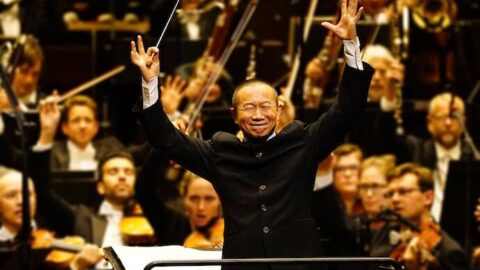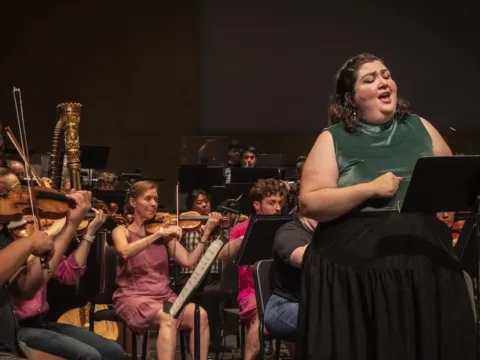Let’s sit Tan Dun on a couch between Beyoncé, Mozart, and Solange. Her Louvre takeover, his operas, and her Guggenheim installation understand Dun’s theatrical flair, interest in visual art, and democratic inspiration. Dun is known as an important concert composer, the musical force behind some of Asia’s biggest spectacles–Heaven Earth Mankind (Symphony 1997) with soloist Yo-Yo Ma celebrating the reunification of Hong Kong to China, Logo Music and Award Ceremony Music for the 2008 Beijing Olympic Games, Shanghai Disneyland 2018 opening ceremony–and as the Grammy-winning composer for the film “Crouching Tiger, Hidden Dragon.” But make no mistake: Tan Dun is interested in high art. He made that explicitly clear at an “East Meets West” panel discussion on September 18th, 2018 at Norway’s Ultima Oslo Contemporary Music Festival. “I am making high art using so-called low culture elements,” he said, intent on responding to an audience probe distinguishing between “high” and “low” culture. “Because life without barriers is interesting.”
Life with barriers is also interesting. Dun and Norwegian violinist Eldbjørg Hemsing’s collaboration included a six-year period of frozen diplomatic relations between Norway and China. The two met as national representatives at Shanghai World Expo 2010, the same year the Norwegian Nobel Committee awarded Chinese human rights activist Liu Xiaobo the Nobel Peace Prize. For the first time in Nobel Peace Prize history, the living recipient was not present to receive the award and it was an “empty chair” ceremony. Over the next six years, the two governments struggled to align, but Hemsing remained dedicated to Dun’s work.
On September 19th, 2018, Ultima and Oslo Philharmonic premiered Dun’s Fire Ritual: A Musical Ritual in Memory for the Victims of War concerto–written for Hemsing after their almost decade of collaboration–as the crux of an all-Dun program. To begin the evening with Passacaglia: Secret of Wind and Birds (2015), Dun asked the audience to play bird recordings found on the Oslo Philharmonic website. The chuckling audience turned their smartphones on and a pleasant wave of birdsong crescendoed through the audience. At Dun’s cue, the audience silenced their phones and the orchestra faded in, acoustically mimicking birdsong on their instruments. (One audience member migrated to Facebook for the remainder of the concert.)

Eventually, the orchestra held its own smartphones in the air, playing birdsong recordings and mirroring the audience’s opening act. Minutes earlier, it had felt like humorous and participatory art; the orchestra’s gesture felt strange. Perhaps it’s because the piece was originally written for the National Youth Orchestra of the United States; but Dun says this kind of thing only becomes a problem when people get old. The rest of Passacaglia alternated between lush orchestrations and sections in which Dun employed a drum kit, palm slaps on the cello neck, and his signature “organic music” rocks for contrasting groove. Passacaglia ended suddenly with bows in the air, and Dun spun around on the podium with baton in the air and a big smile.
It’s mistaken to think of Dun as only a musician. His New York studio is in the Chelsea art district; he makes a point of visiting art museums on regular trips to Shanghai and compares his work to visual code reinvention. His compositions are more like situational sculptures, in which he plays with form and shapes cultural rules into situations for theatrical vision and a good time. “It’s like a sculpture game,” he said of composing. “An artist game, a puzzle game.” Rock the Violin in Rhapsody and A Dream Out of Peking Opera, the latter significantly reworked from its original version, displayed some of this playfulness. In the days leading up to the concert, Dun couldn’t decide if the pieces should be billed as two movements or two separate works. Although the pieces are completely different sound worlds–Hemsing described the first as “Jimi Hendrix meets Peking Opera” and the second as “a fairy tale”–they are philosophical companions exploring the relationship between the individual and the collective via the European concerto.
Hemsing took the evolution in stride, maintaining an unflappable virtuosity despite orchestration that seemed to intentionally drown the soloist in Rhapsody. Wide, warm string and brass sections quickly covered her brief moments of uninterrupted lyricism, which featured collective precision and themes one would typically expect from the soloist. Hemsing’s total dedication was visually if not aurally apparent, and the joke wouldn’t have seemed so cruel had she not taken her allotted moments with unabashed excellence. In Dream, however, the soloist outshines the ensemble. Several times, the orchestra broke off to reveal Hemsing reveling in a lone stratospheric note. She was equally convincing in disjunct, extended technique writing that sounded like radio static or dialup internet, and she glowed in snatches of folk music inspired by the Chinese erhu.

“Contemporary life is a stage,” Dun said. “You bump into people, and that certain bumping is dramatic. There are these racial, human rights, cultural issues–there is conflict daily on the street…It’s not just ancient inspiration like Shakespeare.” In Fire Ritual: A Musical Ritual in Memory for the Victims of War, Dun coupled these modern micro-moments with instrumental staging inspired by ancient Chinese court performances. Dun as shaman conducted a ritual encounter between the Oslo Philhamonic seated onstage (mankind) and solo wind and brass instruments stationed throughout the concert house (Mother Nature). Hemsing opened the piece seated in the audience, and the four seamless chapters “Cruel Wars,” “Innocent People,” “Mantras of the Heavenly Birds,” and “Eternity” flowed from her regal D-natural. Dun augmented the theater by facing the audience and speaking ancient texts before a carefully timed pivot toward the stage. A score of explosive brass and thick orchestration was offset by bird whistles and snatches of woodwinds competing for attention from opposite ends of the concert hall. The distracted nature of these moments recalled the opening work with cell phones held high and Dun’s validation of daily urban life.
For Hemsing as Prophet between ensembles, Dun focused on Re (D-natural) and explored the vast possibility contained within a seeming limitation. “It’s like artists use one stroke, one color,” he said. “There are 100 ways of holding the same pitch [on the violin], of sculpturing Re. Of sound bakering!” He liked this idea as a way to compliment Hemsing. “It’s very difficult to play. [Hemsing] is a sound baker! I give the recipe, I write varieties … she is jumping through Re. It’s great fun.” Indeed, the piece commemorating victims of war was an unexpected amount of fun. Once the orchestra created “wind” by flipping pages of their score back and forth, and audience uniformly laughed at the gesture. I mentioned the laughter to Dun and its sense of hope embedded in trauma. “I used one pitch: Re. Rebirth, recreate, regenerate, reinvent. It’s a RE piece,” he responded. “Commemorating victims, wonderful people, people that we love… it’s a heavy topic. But it needs to be lively and humorous, too. Remembering is not just tears but joy and love.”
























